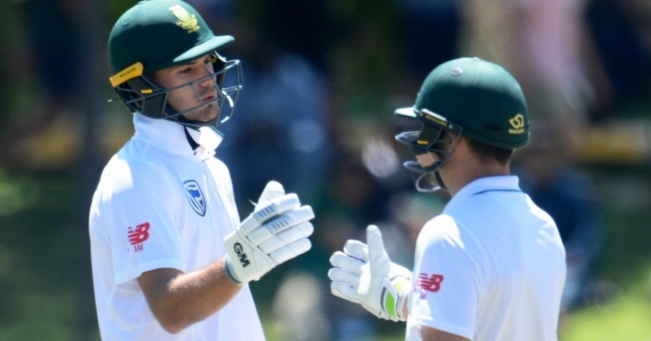Dean Elgar and Aiden Markram go into a two-Test series against the Windies needing to rehabilitate an opening partnership that is rich in potential but lacks in consistency of delivery, writes RYAN VREDE.
At his departure media conference on Monday, Elgar, the newly appointed Test skipper, highlighted the importance of big runs in an individual context as being central to the Proteas’ success. ‘We’ve always had a batting lineup that has scored heavily. And fast bowlers. That’s the South African way,’ Elgar said. ‘We need to get back to scoring big hundreds and taking five-fors like it used to be.’
By extension, big batting partnerships will be crucial – given their galvanising effect on the team, and their demoralising effect on the opposition.
Elgar will be acutely aware that his opening partnership with Markram, which is 44 innings deep, must set the standard in this regard. As it stands, it is nowhere near touching the ceiling of its potential.
The pair have scored 1,535 runs at an average of just 35.70 after 44 innings. This places them sixth in the Proteas’ all-time opening partnerships, having played the fourth-most innings of the group.
They’ve shared three 100-plus partnerships, the highest of which came against Bangladesh in 2017 (243). Worryingly, their last century stand – 141 against a crippled Sri Lanka bowling unit at SuperSport Park in December 2020 – was the first since the aforementioned double-century contribution in 2017. That is self-evidently not good enough for a team that has ambitions on being among the format’s elite.
In addition, there’ve been only eight 50-plus partnerships since the pair’s union. That’s 33 of 44 innings where the partnership has been broken before they’ve reached 50.
Their average of 35.70 pales in comparison to the Proteas’ best opening partnerships. Herschelle Gibbs and Graeme Smith are the pick thereof, scoring 2,983 runs at an average of 55.24 in 56 innings. They are the 10th-best opening pair in Test history (for pairs with a 1,000 or more runs).
Gibbs and Gary Kirsten got 2,283 runs in 52 innings at an average of kissing 45. Smith and Alviro Petersen walked to the wicket on 52 occasions, scoring 2,113 runs at an average of 42.26, while Smith and Neil McKenzie did so 27 times, scoring 1,664 runs at 64.
A relatively short-lived (30 innings) partnership between Smith and AB de Villiers yielded 1,646 runs at an average of nearly 55.
The Proteas have, in modern Test cricket, benefited immensely from Smith’s standout talent and consistency. They’ve been able to manage his partners’ relative inferiority in this regard, and still be a batting force. He was a gift to South African cricket, his value highlighted and reinforced through the process of assessing the Elgar/Markram partnership, one in which neither man has asserted himself on the game to the extent Smith had.
Markram is unquestionably more talented than Elgar, but lacks the latter’s temperament. Smith, of course, had talent and temperament in equal measure. If Markram can develop his game to feature a greater balance of the two in the coming years, the Proteas will benefit greatly.
The impact a player like this has on his opening partner can’t be overstated. Smith’s partners spoke about the calming influence of having a truly world-class opener on the other end. They highlighted his ability to score in unconventional areas off good deliveries, his value from a tactical and mental perspective between overs, and his aggressive approach, which would often stun the opposition into submission, among other attributes.
Markram must become this, or a highly competent version of this, if the Proteas are to return to the game’s elite.
Elgar has scored just one century and three half-centuries in his last 20 innings (it would be remiss not to note scores of 88 and 95 were two of those three 50-plus scores in that period). Nobody will have to tell him that is sub-par. Elgar sets extremely high standards for himself and knows that when he does well, the team usually thrives.
There are plenty of similarities between Elgar and Kirsten, who I believe should be his benchmark on multiple fronts, not least of all his average of 45. Elgar currently sits just shy of 40, but has the potential to match, or get close to, Kirsten’s mark.
Likewise, Markram would do well to benchmark Smith. In appraising him last week, I asserted that Markram, who presently averages 40 in Test cricket, is a 45 talent. He is just 26 years old and has time to build to that level. Smith averaged 48.25, which sets him in rare air. Time will reveal the depth of Markram’s gift, but it is not unreasonable to expect him to scale heights comparable to Smith, such is his talent.
The next Test World Championship cycle will be a decisive one for the Proteas. They have to improve in a multitude of the game’s dimensions, and their opening partnership is one of the most important thereof.
The clock is ticking on this partnership. Fourty-four innings is a more than generous period for an opening pair. But I understand why, given the pair’s potential and the absence of challengers in domestic cricket, this grace has been extended.
The time has come to deliver on that potential.
SA’s best opening partnerships (1,000 or more runs)
1. H Gibbs & G Smith
Period: 2002-08
Innings: 56
Runs: 2,983
Ave: 55.24
2. G Kirsten & H Gibbs
Period: 1998-2002
Innings: 52
Runs: 2,283
Ave: 44.76
3. G Smith & A Petersen
Period: 2010-14
Innings: 52
Runs: 2,113
Ave: 42.26
4. N McKenzie & G Smith
Period: 2008-09
Innings: 27
Runs: 1,664
Ave: 64.00
5. G Smith & AB de Villiers
Period: 2004-08
Innings: 30
Runs: 1,646
Ave: 54.87
6. D Elgar & A Markram
Period: 2017-21
Innings: 44
Runs: 1,535
Ave: 35.70







